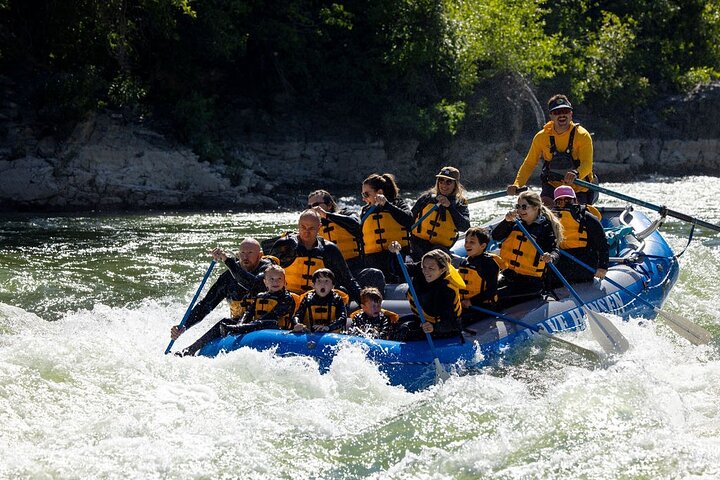Hold On: An 8-Mile Family Whitewater Run Through Jackson Hole
An eight-mile Snake River run that’s built for family thrills and beginner-friendly rapids
The raft leans into the river like a stubborn animal, skirting a seam of froth that throws water into the air and at us. Kids shriek with the quick, clean joy of being soaked; parents laugh and brace for the next pitch. The guide barks a rhythm—left paddle, right paddle—and the boat surges. On the Snake River, the current seems to be daring you forward, nudging at the bottom of your confidence until you wake up to how simple and satisfying a well-timed stroke can be.
Trail Wisdom
Dress for cold water
Even in summer the Snake River is glacier-fed; wear quick-dry layers and consider a splash jacket or wetsuit if you run cold.
Secure valuables
Use a waterproof dry bag or leave phones and keys at the meet-up; unsecured items are likely to be lost in a flip.
Listen to your guide
Paddle commands are concise and intentional—following them improves safety and the overall ride.
Timing matters
Mid-morning runs catch better light and slightly calmer crowds than late afternoon; book accordingly.
Local Knowledge
Hidden Gems
- •Sandbars below take-out popular for a quick picnic and wildlife viewing
- •Short hiking spur near the launch with views back toward the Tetons
Wildlife
Bald eagle, Moose
Conservation Note
Operators follow strict Leave No Trace practices and partners coordinate with park and forest services to minimize impacts on riverbanks and wildlife; pack out all trash and use biodegradable sunscreen where possible.
The Snake River corridor has long been a travel route for Indigenous peoples, and later became central to fur trapping, ranching, and western settlement in the Jackson Hole valley.
Seasonal Guide
spring
Best for: High-flow rapids, Watching runoff, Early-season discounts
Challenges: Cold water, Unpredictable weather, Higher technical difficulty
Spring brings powerful snowmelt and bigger rapids—exciting for thrill-seekers but colder and more dynamic; guides may require wetsuits.
summer
Best for: Warmer air temps, Family-friendly runs, Long daylight
Challenges: More crowds, Warmer but still chilly water, Limited last-minute availability
Summer is the most popular time for family trips—air is warm but the river stays cool; book in advance for weekend slots.
fall
Best for: Fewer crowds, Clear light for photos, Crisp air
Challenges: Shorter days, Cold mornings, Lower flows late season
Fall offers quieter launches and dramatic light with cooling temperatures; flows can be lower but still enjoyable.
winter
Best for: Off-season planning, Learning about the region, Lower operator availability
Challenges: Most outfitters closed, Very cold conditions, Limited services
Winter is largely off-season for river running here; most commercial rafting stops by late autumn due to snow and ice.
Photographer's Notes
What to Bring
Quick-dry clothingEssential
Dries fast and keeps you comfortable when you get soaked.
Closed-toe water shoesEssential
Protects feet on rocky put-ins and provides grip in the raft.
Lightweight waterproof jacket or splash top
Adds warmth and wind protection during colder months or high-water runs.
Dry bag and wrist-strap for camera/phoneEssential
Keeps valuables dry and secures them to you if you capsize.
Common Questions
How long is the rafting trip?
The full experience is about four hours from meeting to drop-off, including safety briefing, transport to the put-in, and the eight-mile river run.
Is this trip suitable for kids?
Yes—this Family Standard Raft is designed for families and mixed-ability groups; children should be comfortable following guide instructions and wearing a life jacket.
What should I wear?
Wear quick-dry clothing and closed-toe water shoes; bring a hat and sunscreen. In colder months ask the operator about wetsuit or splash jacket availability.
Do I need prior rafting experience?
No—guides provide instruction and manage technical maneuvers; some paddling participation is expected.
What’s the water temperature like?
The Snake River is snowmelt-fed and remains cool even in summer; expect brisk water and bring layers if you run cold.
Are reservations required?
Yes—this experience often sells out during peak season and requires manual confirmation, so book ahead to secure your preferred date and time.
What to Pack
Water shoes for traction, quick-dry clothing for comfort, sunscreen to protect exposed skin, dry bag to keep electronics safe
Did You Know
The Snake River’s path through Jackson Hole was shaped significantly by Pleistocene glaciations and the uplift of the Teton fault, exposing dramatic vertical relief in a relatively short distance.
Quick Travel Tips
Book morning slots for better light; bring layers for changing temps; inform the operator of any mobility concerns ahead of time; tip guides in cash if possible
Local Flavor
After the run, head back to Jackson for a local elk burger and a craft beer at a downtown pub, or warm up with coffee and a pastry at a bakery. Wander the Town Square for Western art, or visit a local ranch store to pick up a hat as a souvenir.
Logistics Snapshot
Closest airport: Jackson Hole Airport (JAC); Typical meeting point: Jackson, WY; Driving distance to put-in: usually 10–30 minutes; Cell service: intermittent along river; Permits: none for commercial trips, but check park entry rules if combining with other activities
Sustainability Note
This river corridor runs through protected lands—pack out all trash, avoid single-use plastics, and use reef-safe sunscreen to limit chemical runoff into the water.
